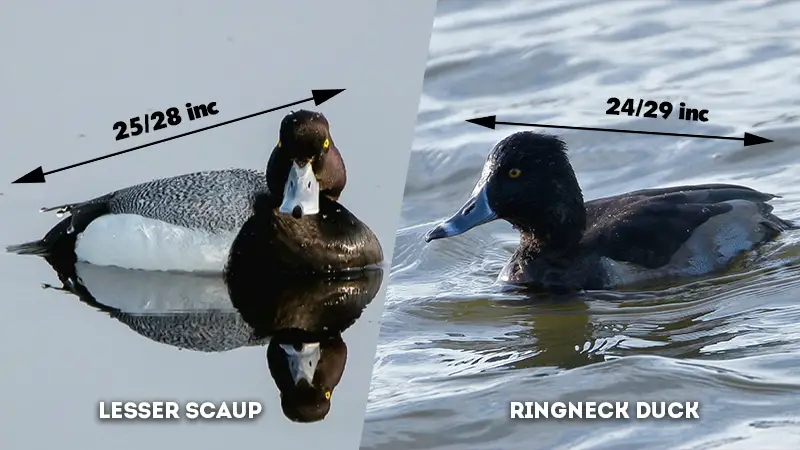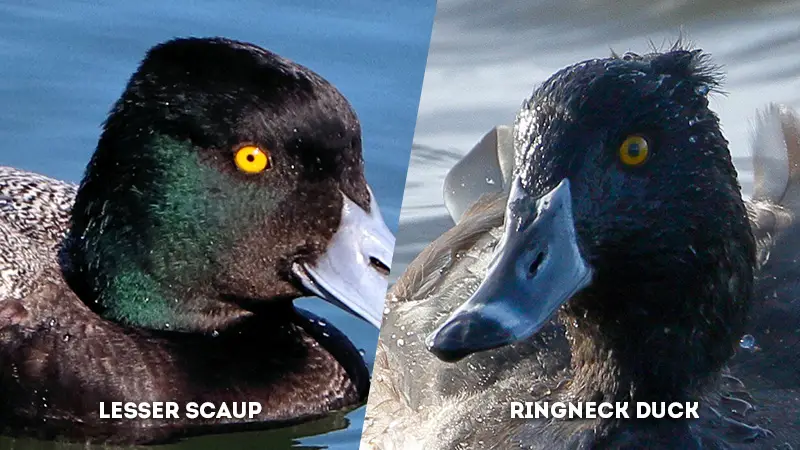The lesser scaup and ringneck duck, two distinct avian species inhabiting North America, captivate with their intricate features and behaviors. From their contrasting plumage to their migratory patterns, these ducks offer a fascinating glimpse into the intricate tapestry of nature.
Not only do they grace diverse wetland habitats, but their interactions within ecosystems also impact the delicate balance of flora and fauna. As migratory wonders, they traverse vast distances to seek temperate refuge during winter months.
Delving deeper into their unique vocalizations, nesting strategies, and population dynamics provides a deeper appreciation for their role as iconic members of the avian realm, enriching the landscapes they call home.

Key Differences Between Lesser Scaup and Ringneck Duck
Here are some of the main differences between lesser scaup and ring-necked ducks:
Bill Shape and Size
- Lesser Scaup: The lesser scaup exhibits a short and rounded bill, distinguished by its bluish tint.
This compact bill is notably smaller in proportion to its head, aligning with the duck’s smaller size. The bill’s tip is adorned with a subtle black marking, a key characteristic for identification. - Ringneck Duck: Contrastingly, the ringneck duck boasts a tapered grayish bill. Notably, a distinctive white ring encircles the base of the bill, near its face.
While larger than that of the lesser scaup, this bill contributes to the ringneck duck’s unique appearance and aids in its differentiation from the lesser scaup.
Size

- Lesser Scaup: The lesser scaup, as its name suggests, is characterized by its smaller size within the duck community.
Measuring between 15 to 18 inches in length and boasting a wingspan of 25 to 28 inches, this duck’s compact stature is reminiscent of the mallard. Its diminutive size is a key feature that aids in its differentiation from the larger ringneck duck. - Ringneck Duck: In contrast, the ringneck duck exhibits a slightly larger size, while still falling within the range of medium-sized ducks.
With a length spanning from 14 to 18 inches and a wingspan of 24 to 29 inches, the ringneck duck stands out as marginally bigger than the lesser scaup. This size distinction plays a pivotal role in visually distinguishing these two species.
Plumage (Male)
- Lesser Scaup: During the breeding season, the male lesser scaup showcases a distinctive pattern of plumage. It features a dark iridescent head, accompanied by a black breast and a subtle gray body.
This combination of colors creates an elegant contrast that enhances its aesthetic appeal. Notably, the lesser scaup’s back remains predominantly black, solidifying its unique appearance. - Ringneck Duck: The male ringneck duck, in its breeding plumage, flaunts a captivating blend of black and white. The back and sides are dominated by deep black, while a striking white ring encircles its neck, lending the species its name.
The head is glossy black with a captivating purple sheen. This exceptional plumage, characterized by the white neck ring, is an unmistakable feature distinguishing it from the lesser scaup.
Habitat and Range
- Lesser Scaup: Both the lesser scaup and the ringneck duck exhibit a preference for freshwater habitats, such as lakes, ponds, and marshes.
However, the lesser scaup tends to be found in these habitats during migration and wintering seasons. Their wintering range spans across North and Central America. - Ringneck Duck: Similar to the lesser scaup, the ringneck duck thrives in freshwater ecosystems like lakes, ponds, and marshes. It shares its wintering range with the lesser scaup across North and Central America.
Their overlapping habitat preferences underscore the importance of paying attention to additional characteristics for accurate identification.
Behavior
- Lesser Scaup: The lesser scaup, like its counterpart, is a diving duck. It engages in diving behavior to forage for aquatic vegetation and invertebrates beneath the water’s surface.
This behavior is an adaptation that allows it to access its food sources efficiently, making it well-suited for its preferred freshwater habitats. - Ringneck Duck: Similarly, the ringneck duck is known for its diving behavior, which involves plunging beneath the water to secure its sustenance.
This includes consuming aquatic plants and small invertebrates. This shared behavior between the lesser scaup and the ringneck duck aligns with their ecological roles in their respective habitats.
Head Color

- Lesser Scaup: The head color of the lesser scaup is a defining characteristic, especially during the breeding season. The male lesser scaup sports a strikingly dark iridescent head that gleams with shades of deep green and purple when caught in the right light.
This dark and captivating head coloration is a distinct feature that sets the lesser scaup apart from other ducks in its range. - Ringneck Duck: In contrast, the ringneck duck boasts a head color that is entirely different from that of the lesser scaup. The male ringneck duck displays a glossy black head with a noticeable purple sheen.
The juxtaposition of black and purple, coupled with its white neck ring, creates a visually stunning and unmistakable appearance. This unique head coloration makes the ringneck duck instantly recognizable in its natural habitat.
Neck Ring
- Lesser Scaup: One of the most prominent differences between the two species lies in the presence of a neck ring. In the lesser scaup, a distinct neck ring is notably absent.
Instead, its plumage transitions smoothly from the dark head to the lighter gray body without any interruption. This lack of a neck ring is a key feature that aids in distinguishing the lesser scaup from its counterparts. - Ringneck Duck: The ringneck duck derives its name from the striking white ring that encircles its neck, just above its breast. This prominent and defining feature is a hallmark of the species and serves as a quick and reliable identifier.
The contrast between the black head, white neck ring, and black breast creates an arresting pattern that distinguishes the ringneck duck from other waterfowl species.
Back Color
- Lesser Scaup: The lesser scaup’s back color aligns with its general plumage pattern. The male lesser scaup features a predominantly black back, creating a seamless continuation from its dark head.
This uniformity of coloration contributes to its sleek appearance and aids in its camouflage within its preferred aquatic habitats. - Ringneck Duck: The back color of the ringneck duck echoes its overall color scheme. Similar to its head, the male ringneck duck’s back is also dominated by black plumage.
This uniformity of color extends from the head down the back, creating a cohesive and distinctive appearance that complements the species’ unique features, such as the white neck ring.
Breast Color
- Lesser Scaup: The male lesser scaup’s breast color aligns with its darker plumage. The breast of the lesser scaup is adorned in rich black, which seamlessly transitions from the dark head and back. This consistency in coloration contributes to the overall unity of its plumage and aids in its identification.
- Ringneck Duck: The black coloration of the ringneck duck’s breast complements its overall pattern. The male ringneck duck features a black breast that resonates with the coloration of its head and back.
This harmonious color distribution, combined with its distinct white neck ring, creates a visually captivating contrast that easily sets it apart.
Body Color
- Lesser Scaup: The male lesser scaup’s body color is characterized by subtle variations in gray tones. Its body exhibits a smooth transition from the darker head and breast to the lighter shades of gray.
This muted yet elegant coloration enables the duck to blend into its wetland environments while maintaining its distinctiveness. - Ringneck Duck: While the ringneck duck’s head, neck ring, breast, and back showcase striking black-and-white contrasts, its body is dominated by a seamless expanse of dark gray.
This coloration serves as a backdrop that enhances the visual impact of its head and neck ring. The overall effect is a balance of bold and subtle hues that define the ringneck duck’s appearance.
Bill Color
- Lesser Scaup: The bill color of the lesser scaup complements its overall coloration. The bill is characterized by a bluish tint, which stands out against its dark iridescent head. The bluish hue of the bill, coupled with its smaller size, forms an integral part of the lesser scaup’s distinctive appearance.
- Ringneck Duck: The bill color of the ringneck duck differs notably from that of the lesser scaup. The bill of the ringneck duck is grayish in hue, a shade that harmonizes with its overall plumage. This muted coloration, along with the duck’s larger bill size, contributes to its unique profile.
Bill Size
- Lesser Scaup: The bill size of the lesser scaup is relatively small compared to the duck’s head. This proportionally small bill aligns with the duck’s compact size and adds to its characteristic look. The bill’s tip is marked with a subtle black spot, creating a distinct feature for identification.
- Ringneck Duck: Contrasting with the lesser scaup, the ringneck duck possesses a larger bill. The bill is proportionate to its size and contributes to the duck’s distinct facial structure.
This larger bill, along with its grayish color, is another key element that aids in distinguishing the ringneck duck from other species.
Eye Color

- Lesser Scaup: The eye color of the lesser scaup is a striking yellow, a hue that stands out against its dark head. This vibrant eye color is particularly visible when observing the duck from a close distance, adding to the allure of its appearance.
- Ringneck Duck: Similarly, the ringneck duck’s eye color is also a vivid yellow, mirroring the brightness of its plumage. The yellow eyes of the ringneck duck, combined with its contrasting head color and neck ring, contribute to its captivating and easily recognizable look.
Legs and Feet Color

- Lesser Scaup: The legs and feet of the lesser scaup are colored in a subtle gray shade. This coloration complements the duck’s overall plumage and provides a muted contrast against its darker features. The gray legs and feet enhance the duck’s ability to blend into its aquatic habitat.
- Ringneck Duck: The legs and feet of the ringneck duck share a similar gray coloration. This consistent color theme extends from its bill to its extremities, creating a harmonious appearance. The gray legs and feet, combined with its black and white plumage, contribute to the duck’s distinct visual appeal.
Size (Female)
- Lesser Scaup: In terms of size, the female lesser scaup is relatively similar to the male. It maintains the smaller size characteristic of the species, with a length ranging from 15 to 18 inches and a wingspan spanning 25 to 28 inches. This size similarity between genders is an important feature for identification.
- Ringneck Duck: Similarly, the size of the female ringneck duck is comparable to that of the male. With a length ranging from 14 to 18 inches and a wingspan spanning 24 to 29 inches, the female ringneck duck shares the species’ size traits. This uniformity in size helps differentiate the ringneck duck from other waterfowl species.
Migration
- Lesser Scaup: The lesser scaup is a migratory bird that undergoes seasonal movements. During the breeding season, it can be found in northern regions of North America.
However, for the winter, it migrates to more temperate and southern areas, including Central and North America. - Ringneck Duck: Similar to the lesser scaup, the ringneck duck is also a migratory species. It breeds in northern regions and then migrates to wintering grounds in more hospitable regions.
The ringneck duck’s migratory pattern spans across North America, including parts of the United States and southern Canada.
Wintering Range
- Lesser Scaup: The lesser scaup’s wintering range covers a broad expanse of North America. These ducks can be found in various habitats such as lakes, ponds, and coastal areas during the winter months.
Their wintering range extends from the southern United States to Central America, providing them with a diverse range of winter habitats. - Ringneck Duck: The ringneck duck’s wintering range is also extensive, encompassing a similar geographical area to that of the lesser scaup.
These ducks can be observed in a variety of wetland habitats, including freshwater lakes, rivers, and marshes. Their range extends from the southern United States to parts of Mexico and Central America.
Voice
- Lesser Scaup: The lesser scaup’s vocalizations include a range of soft whistles and quacks. These calls are often heard during courtship and interactions with other ducks.
The calls of the lesser scaup contribute to the auditory landscape of wetland habitats and can be used for identifying the species by sound. - Ringneck Duck: The ringneck duck is known for its varied vocalizations, which include quacks and grunts. These calls are distinct and can be heard during interactions with other ducks, especially during the breeding season.
The vocalizations of the ringneck duck provide valuable cues for species identification and communication.
Nesting Habits
- Lesser Scaup: The nesting habits of the lesser scaup involve nesting close to water bodies. Females construct nests hidden in vegetation near the water’s edge.
These nests are well-camouflaged and provide protection for the eggs and ducklings. The lesser scaup’s nesting strategy aligns with its preference for aquatic habitats. - Ringneck Duck: Similarly, the ringneck duck’s nesting habits also revolve around water bodies. Females build concealed nests in dense vegetation near the water, offering a secure environment for their eggs and young. The nesting behavior of the ringneck duck reflects its adaptation to wetland ecosystems.
Population
- Lesser Scaup: The population of the lesser scaup has shown stability over time. While there have been concerns about fluctuations in numbers, overall, the species has maintained a relatively steady population.
Conservation efforts are important to ensure that the species continues to thrive, especially considering its migratory behavior and dependence on various habitats. - Ringneck Duck: Similar to the lesser scaup, the ringneck duck’s population is also considered stable. Conservation initiatives play a vital role in maintaining healthy populations of these ducks.
Given their reliance on wetland ecosystems and their role in maintaining ecological balance, monitoring and protecting their habitats are crucial.
Lesser Scaup Vs Ringneck Duck: Comparison Table
| Feature | Lesser Scaup | Ringneck Duck |
|---|---|---|
| Bill Shape and Size | Short, rounded bill with bluish tint | Tapered bill, grayish, white ring near face |
| Size | Smaller, length 15-18″, wingspan 25-28″ | Slightly larger, length 14-18″, wingspan 24-29″ |
| Plumage (Male) | Dark iridescent head, black breast, gray body | Black back and sides, white neck ring |
| Habitat and Range | Freshwater lakes, ponds, marshes | Freshwater lakes, ponds, marshes |
| Behavior | Diving for aquatic vegetation, invertebrates | Diving for aquatic vegetation, invertebrates |
| Head Color | Dark iridescent | Black with purple sheen |
| Neck Ring | Absent | White ring around neck |
| Back Color | Mostly black | Black |
| Breast Color | Black | Black |
| Body Color | Gray | – |
| Bill Color | Bluish with black tip | Gray |
| Bill Size | Relatively small | Proportionally larger |
| Eye Color | Yellow | Yellow |
| Legs and Feet Color | Gray | Gray |
| Size (Female) | Similar to male, slightly smaller | Similar to male, slightly smaller |
| Migration | Migratory | Migratory |
| Wintering Range | North and Central America | North and Central America |
| Voice | Soft whistles and quacks | Quacks and grunts |
| Nesting Habits | Nests close to water, hidden in vegetation | Nests near water, well-hidden in vegetation |
| Population | Stable | Stable |
Frequently Asked Questions
Both the lesser scaup and ringneck duck adapt to various wintering habitats by seeking out areas with milder climates and suitable food sources. They utilize a range of wetland environments, including lakes, rivers, and coastal areas, to find adequate food and shelter during the colder months.
Yes, both ducks exhibit distinct courtship behaviors. The lesser scaup engages in coordinated group displays where males and females swim in synchronized patterns. The ringneck duck, on the other hand, displays a more elaborate courtship with males engaging in head bobbing and body movements to attract females.
The lesser scaup and ringneck duck play crucial roles in their ecosystems by participating in nutrient cycling. As diving ducks, they feed on aquatic plants and invertebrates, helping control populations of these organisms. Their migrations also contribute to the dispersal of seeds and nutrients across various habitats.
The lesser scaup and ringneck duck mitigate competition for resources by utilizing different foraging strategies and focusing on specific types of food. Their varying bill structures allow them to access different food sources in their wintering habitats, reducing direct competition and promoting coexistence.
While both species have generally stable populations, there are ongoing concerns about habitat loss due to human activities, pollution, and climate change. Conservation efforts are essential to safeguard their wintering and breeding habitats, ensuring these ducks continue to thrive and contribute to the health of wetland ecosystems.
To Recap
The lesser scaup and ringneck duck exemplify the captivating diversity present within waterfowl species. Their distinct characteristics, from bill size to migratory behaviors, paint a vivid portrait of their adaptation to various habitats and roles within ecosystems.
As they navigate their annual cycles, these ducks contribute to the intricate web of life, shaping wetland environments and influencing the vitality of their surroundings.
By appreciating the nuances of their appearance, behaviors, and ecological significance, we gain a deeper understanding of the remarkable avian world and the importance of preserving these species for generations to come.